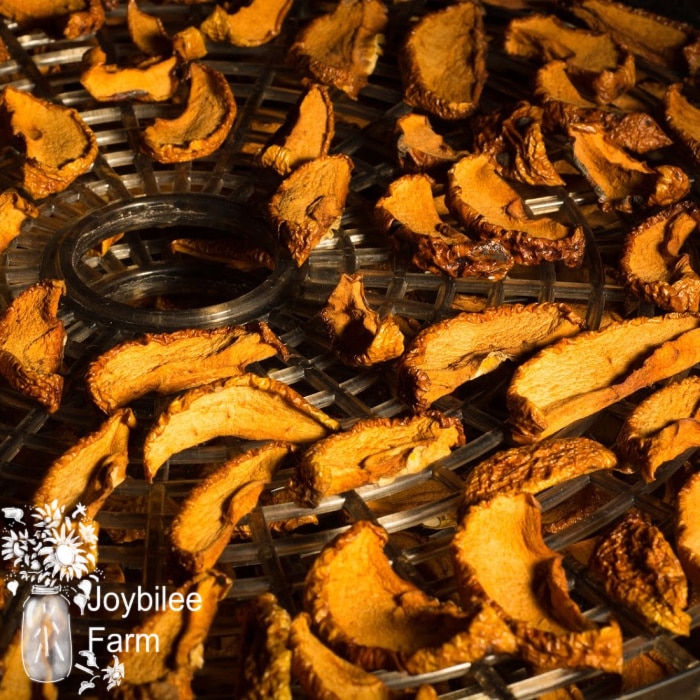Getting the most out of your dehydrator isn’t always easy. These dehydrator tips from experienced homesteaders contain a few ways to improve dehydrator efficiency and food safety, so you can get the most out of your dehydrator. Even if you are experienced with food dehydration, these dehydrator tips may still be new.
Dehydration is one of the oldest methods of food preservation. Many traditional dehydration techniques used solar power to dry fruits, and sometimes vegetables, for winter use. Traditionally, native American tribes dehydrated berries, herbs, and meat. Our modern day dehydrators are highly versatile tools for homestead food preservation. A good dehydrator can help you preserve hundreds of pounds of produce, fruit, and even meats, every year.
Dehydrated foods are light, easy to store, and have good shelf life. If you are dehydrating for a family, shelf life may not be as relevant. Growing up, my family frequently consumed the majority of our dehydrated fruits, fruit leather, and berries every single year. Vegetables took longer, they were usually only used in winter soups and had limited snack-ability, unlike dried apples and fruit leather.

Whether you are interested in dehydrating for fun, practicality, or food preservation, these dehydrator tips can help you get the most out of your investment. Dehydrators are also lower heat outputs than stoves, when canning, jellies, jams, and sauces are on the preservation schedule. A dedicated dehydrator is also more energy efficient than using your electric stove for the same purpose, even on the lowest settings. An exception may be homemade jerky, if your dehydrator cannot reach 165F.
Some fun things to dehydrate include apricots, and of course, there’s always apples, strawberries and mushrooms too!
Dehydrator Tips # 1
“This is one I stand by: Save your money and purchase the best dehydrator you can afford. A dehydrator with a rear fan will dry the food items evenly, faster, and more efficiently than one which has a top or bottom fan. Hence, minimizing the time spent rotating the drying trays and the time spent drying foods.” — Ann Accetta-Scott
Dehydrator Tips # 2
” Store in glass! I was fine storing my dried fruits in big plastic tubs when I lived in an Alpine desert. Now that I live in the American southwest, my dried fruit is more apt to get sticky and even mold if it’s stored in plastic because of the high humidity. Half gallon canning jars have worked much better for us!” — Tessa Zundel
Dehydrator Tips # 3
“Turn apricots inside out. Slice the fruits in half, remove the pit then push the skin up into the flesh so it sticks out some, exposing more of the juicy flesh to dry faster.” — Kathie Lapcevic
This technique is also relevant for other small stone fruits. Cherries, plums, damson plums, and even large seeded grapes can have this technique applied to help with drying. This tip also helps reduce the chance of the fruit “sealing” before the inner flesh can dry.

Dehydrator Tips # 4
Dry like with like, fruits with fruits, veggies with veggies. Some strongly scented veggies will permeate fruits with their odor while drying, so drying fruit separately from veggies keeps from cross contamination. It is the same with spicy foods. Hot peppers should be dried on their own, or only with items that you don’t mind turning spicy. Once we dried tomato skins with jalapeno peppers, and the tomato skins got the seeds that fell from the jalapenos and ended up quite spicy. It worked well for spicy chili mix tomato powder, but not as well for the accidental hot peppers in the eyes when the tomato skins were handled without gloves. — Chris Dalziel
Dehydrator Tips # 5
Blanche low acid foods before dehydrating to remove surface bacteria, soften skins, and improve preservation. Foods that should be blanched include carrots, corn, broccoli, peas, beans, potatoes, and asparagus. Blanching can also reduce odors from strong smelling vegetables. Store fruits and vegetables separate, if you are using plastic, as odors can permeate between fruits and veggies. If you make kale chips, or other coated, strong-smelling veggie chips, you will want to keep them separate from other veggies as well. — Sarah Kirchhevel
Dehydrator Tips # 6
“Don’t forget to condition fruit. Since most dehydrated fruit is leathery or bendy instead of crisp it can be hard to know if it’s dehydrated enough for storing. Put the dried fruit in a glass jar and leave it on the counter for 7 days. Each day look to see if any condensation forms. If it doesn’t, it’s fully dehydrated and safe for storing. If condensation forms, the fruit needs to go back into the dehydrator to finish drying.” — Angi Schneider
Dehydrator Tips # 7
“Some pieces of dehydrated fruit may retain a bit more moisture than others due to inconsistencies in thickness. It’s a good idea to condition the fruit before storing it. To do this, cool the dried fruit thoroughly then pack loosely in a large jar. Seal the jar and let is stand for a week or so, shaking it daily to break up the fruit. The excess moisture in some pieces will be reabsorbed by drier pieces. (If condensation appears inside the jar at this point, there’s still too much moisture in the fruit; return it to the dehydrator to remove more moisture.) Once conditioned, your fruit is ready to be packed for longer-term storage.” — Kris Bordessa
Dehydrating Tips #8:
When dehydrating, it is recommended to never raise the temperature to try and get a faster dry time for fruits and vegetables. If the dehydrator temperature is too high, to start, fruit sugars can burn, and the outside of the fruit or vegetable can seal and prevent full dehydration. If the inside of your fruits seems soft and squishy, slice them again and put them back in — Don’t condition them if it is obvious they are still very under-dehydrated. Only condition fruits/veggies that appear to be fully dehydrated. One under dehydrated piece of fruit can ruin the entire container if it goes moldy. — Chris Dalziel
Start fruit dehydrating at 125F, and drop to 115F to finalize drying. Temperatures above 125F are what can prevent the center of the fruit from drying properly. Vegetables should be started at 135F and dropped to 125F for drying. Tomatoes count as a fruit in this case. Jerky should be dried at 165F, as it is a meat product.
Dehydrating Tips #9
Low acid fruits and vegetables can also be dipped in a lemon juice mixture to prevent browning, or sprayed with lemon juice for the same effect. I haven’t noticed a strong difference in color between apples treated with lemon juice, and non-treated, so try both and see which you prefer. Use the juice of 1 lemon or 2 tablespoons of canned lemon juice per cup of water. Dip the fruit into the lemon juice before adding it to the dehydrator trays. — Chris Dalziel
Your Turn:
What advice would you give to someone new to using a dehydrator? What is your favorite thing to make in your dehydrator? Leave a comment, we’d love to hear from you.



I use pineapple juice to soak apples and pears before dehydration. Works great to reduce browning.